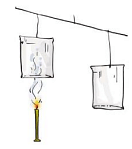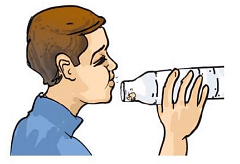Winds, Storms and Cyclones Class 7 Worksheet Science
Q.1. True/False
(i) In summer the winds flow from the land towards the ocean.
False
(ii) In winter the winds flow from the land to the ocean.
True
(iii) A cyclone is formed by a very high-pressure system with very high-speed winds revolving around it.
False
(iv) The coastline of India is not vulnerable to cyclones.
False
(v) Increased wind speed is accompanied by a reduced air pressure.
True
(vi) Regions close to the equator get maximum heat from the Sun.
True
Q.2. Fill in the blanks.
(i) Wind is ____ air.
moving
(ii) Winds are generated due to ____ heating on the earth.
uneven
(iii) Near the earth’s surface ____ air rises up whereas ____ air comes down.
warm, cooler
(iv) Air moves from a region of ____ pressure to a region of ____ pressure.
high, low
(v) Air ____ on heating.
expands
(vi) Warm air is ____ than the cold air.
lighter
Q.3. What do tornadoes look like?
Tornadoes can appear as a traditional funnel shape, or in a slender ropelike form.
Q.4. Hold a strip of paper, 20 cm long and 3 cm wide, between your thumb and forefinger. Now blow over the paper. What do you think will happen to the paper? Give reason.
When we blew over the paper strip, it went upwards. This could happen if blowing over the paper reduced the air pressure above the strip.
Q.5. Explain why holes are made in hanging banners and hoardings.
Air exerts pressure. It is due to this pressure that the banners or hoardings flutter and torn when the wind is blowing. Holes are made in hanging banners and hoardings so that air can pass through these holes, which reduces the air pressure on the banners and hoardings.
Q.6. You want to buy a house. Would you like to buy a house having windows but no ventilators? Explain your answer.
As warm air rises, air pressure at that place is reduced and the cooler air moves to that place. This warm air goes out from the house mostly through ventilators. If a house does not have ventilators then the warm cannot go out easily and circulation of air will not happen. Hence, I would not prefer a house having windows but no ventilators.
Q.7. What precautions would you take, if you are staying in a cyclone hit area?
Some precautions, if we are staying in a cyclone hit area —
(i) Do not drink water that could be contaminated. Always store drinking water for emergencies.
(ii) Do not touch wet switches and fallen power lines.
(iii) Do not go out just for the sake of fun.
(iv) Do not pressurise the rescue force by making undue demands.
(v) Cooperate and help your neighbours and friends.
Q.8. How technologies help people to be protected from cyclone?
These days we are better protected. In the early part of the last century coastal residents may have had less than a day to prepare or evacuate their homes from an oncoming cyclone. The world today is very different. Thanks to satellites and radars, a Cyclone alert or Cyclone watch is issued 48 hours in advance of any expected storm and a Cyclone warning is issued 24 hrs in advance. The message is broadcast every hour or half hour when a cyclone is nearer the coast. Several national and international organisations cooperate to monitor the cyclone-related disasters.
Q.9. When you fly a kite, does the wind coming from your back help?
Yes, the force of the wind pushes the kite upwards and backwards.
Q.10. What is the main cause of wind movement?
Uneven heating on the earth is the main cause of wind movements.
Q.11. Where do thunderstorms usually develop?
Thunderstorms develop in hot, humid tropical areas like India very frequently.
Q.12. From where does the word monsoon derived? What does it mean?
The word monsoon is derived from the Arabic word ‘mausam’, which means ‘season’.
Q.13. Explain why smoke always rises up?
On heating the air expands and occupies more space. When the same thing occupies more space, it becomes lighter. The warm air is, therefore, lighter than the cold air. That is the reason that the smoke goes up.
Q.14. List some effective safety measures for cyclone.
Some effective safety measures are:
(i) A cyclone forecast and warning service.
(ii) Rapid communication of warnings to the Government agencies, the ports, fishermen, ships and to the general public.
Q.15. Why is it difficult to force the paper ball into the bottle?
When we blow into the mouth of the bottle the air near the mouth has higher speed. This decreases the pressure there. The air pressure inside the bottle is higher than near the mouth. The air inside the bottle pushes the ball out. Thus, it is difficult to force the paper ball into the bottle.
Q.16. Take a soft plastic bottle. Fill it with hot water. Empty the bottle and immediately cap it tightly. Place the bottle under running water. Shape of the bottle gets distorted. Explain why the bottle gets distorted?
As water is poured over the bottle, some steam in the bottle condenses into water, reducing the amount of air inside. The pressure of air inside the bottle decreases than the pressure exerted by the air from outside the bottle. As a result the can gets compressed.
Q.17. How will you help your neighbours in case cyclone approaches your village/town?
I will help my neighbours in case cyclone approaches our village/town:
(i) By making them aware of cyclone forecast and warning service.
(ii) By helping them to shift the essential household goods, domestic animals and vehicles, etc. to safer places.
(iii) By calling emergency services like police, fire brigade, and medical centres in case of need.
Q.18. List some action on the part of people in case of cyclone.
Action on the part of people in case of cyclone
(i) We should not ignore the warnings issued by the meteorological department through TV, radio, or newspapers.
(ii) We should — make necessary arrangements to shift the essential household goods, domestic animals and vehicles, etc. to safer places; avoid driving on roads through standing water, as floods may have damaged the roads; and keep ready the phone numbers of all emergency services like police, fire brigade, and medical centres.
Q.19. Write an experiment to show that on heating the air expands and occupies more space.
Take two paper bags or empty paper cups of the same size. Hang the two bags in the inverted position on the two ends of a metal or wooden stick. Tie a piece of thread in the middle of the stick. Hold the stick by the thread as in a balance. Put a burning candle below one of the bags. We will see that the balance of the bags gets disturbed. This happen as the warm air rises up, it pushes the bag above the candle.
Q.20. High speed winds are accompanied by reduced air pressure. Prove the statement with help of an experiment.
Crumple a small piece of paper into a ball of size smaller than the mouth of an empty bottle. Hold the empty bottle on its side and place the paper ball just inside its mouth. Now try to blow on the ball to force it into the bottle. When we blow into the mouth of the bottle the air near the mouth has higher speed. This decreases the pressure there. The air pressure inside the bottle is higher than near the mouth. The air inside the bottle pushes the ball out.
FAQs on Winds, Storms and Cyclones Class 7 Worksheet Science
| 1. What causes a cyclone? |  |
| 2. How are storms and cyclones different? |  |
| 3. What is the role of wind in a cyclone? |  |
| 4. How do cyclones affect coastal areas? |  |
| 5. How can we stay safe during a cyclone? |  |

|
Explore Courses for Class 7 exam
|

|



















